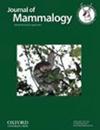Hibernacula of bats in Mexico, the southernmost records of hibernation in North America
IF 1.6
3区 生物学
Q2 ZOOLOGY
引用次数: 0
Abstract
Although Mexico holds the southernmost hibernating bats in North America, information on winter behavior and hibernacula microclimate use of temperate Mexican bats is limited. We studied hibernating bats at high altitudes (>1,000 m a.s.l.) in northern and central Mexico during 5 consecutive winters. Our aims were to document and describe the hibernacula, winter behavior (such as abundance and roost pattern), and microclimates (estimated as adjacent substrate temperature) of cave-hibernating bats in Mexico. We found 78 hibernacula and 6,089 torpid bats of 10 vespertilionid species, increasing by over 50% the number of cave-hibernating bat species and quadrupling the number of hibernacula for Mexico. Hibernacula were at altitudes between 1,049 and 3,633 m a.s.l., located in 3 mountain ranges, mainly in oak and conifer forests. Myotis velifer was the most common species, followed by Corynorhinus townsendii and C. mexicanus. We recorded the adjacent substrate temperatures from 9 species totaling 1,106 torpid bats and found differences in microclimate use among the 3 most common species. In general, abundance of torpid bats in our region of study was similar to those in the western United States, with aggregations of tens to a few hundred individuals per cave, and was lower than in the eastern United States where a cave may hold thousands of individuals. Knowledge of bat hibernation is crucial for developing conservation and management strategies on current conditions while accommodating environmental changes and other threats such as emerging diseases.墨西哥蝙蝠的冬眠室,北美洲最南端的冬眠记录
虽然墨西哥是北美洲最南端的冬眠蝙蝠栖息地,但有关墨西哥温带蝙蝠冬季行为和冬眠微气候利用的信息却很有限。我们对墨西哥北部和中部高海拔地区(海拔 1,000 米)的冬眠蝙蝠进行了连续 5 个冬季的研究。我们的目的是记录和描述墨西哥洞穴冬眠蝙蝠的冬眠洞穴、冬季行为(如数量和栖息模式)以及微气候(根据邻近基质温度估算)。我们发现了 78 个冬眠洞穴和 10 种吠形目蝙蝠的 6,089 只蝙蝠,使墨西哥洞穴冬眠蝙蝠的种类增加了 50%以上,冬眠洞穴的数量翻了两番。冬眠洞穴位于海拔 1 049 米至 3 633 米之间,分布在 3 个山脉,主要在橡树林和针叶林中。绒螯蝠是最常见的物种,其次是Corynorhinus townsendii和C.我们记录了 9 个物种共 1,106 只疣蝠的邻近基底温度,发现 3 个最常见物种对微气候的利用存在差异。总体而言,我们研究地区的鳞蝠数量与美国西部相似,每个洞穴聚集几十只到几百只不等,低于美国东部一个洞穴可能聚集几千只的数量。对蝙蝠冬眠的了解对于根据当前条件制定保护和管理策略,同时应对环境变化和其他威胁(如新出现的疾病)至关重要。
本文章由计算机程序翻译,如有差异,请以英文原文为准。
求助全文
约1分钟内获得全文
求助全文
来源期刊

Journal of Mammalogy
生物-动物学
CiteScore
3.30
自引率
5.90%
发文量
106
审稿时长
4-8 weeks
期刊介绍:
Papers are published on mammalian behavior, conservation, ecology, genetics, morphology, physiology, and taxonomy.
 求助内容:
求助内容: 应助结果提醒方式:
应助结果提醒方式:


